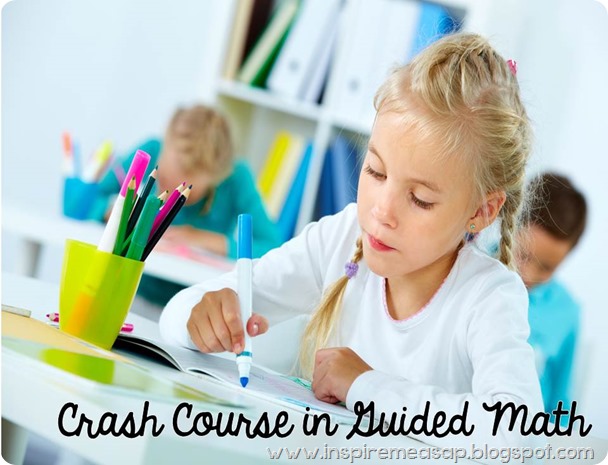 When I first began my teaching career 14 years ago (oh my has it really been that long!?!), a very wise teacher told me to pick one are to focus on every year and make it be your mission to master that area of teaching. Well, since it seems that education is (or at least WAS!) so focused on literacy, that is where I focused my growth as an educator. I observed other master teachers, went to conferences, read MANY professional books- initially about guided reading and then switched my focus to a reading workshop approach. I then focused a couple of years on really mastering the art of using a reading workshop approach to literacy- which I firmly believe is an extremely effective way to differentiate instruction and meet the needs of all your learners. (NOT just the struggling ones!) I eventually learned more about using the 6 traits of writing and teaching those traits during a writing workshop mini-lesson. I focused on improving my writing instruction for the next several years. So it would seem like a natural progression to focus on improving my math instruction- which has been a professional goal of mine for the past three years.
When I first began my teaching career 14 years ago (oh my has it really been that long!?!), a very wise teacher told me to pick one are to focus on every year and make it be your mission to master that area of teaching. Well, since it seems that education is (or at least WAS!) so focused on literacy, that is where I focused my growth as an educator. I observed other master teachers, went to conferences, read MANY professional books- initially about guided reading and then switched my focus to a reading workshop approach. I then focused a couple of years on really mastering the art of using a reading workshop approach to literacy- which I firmly believe is an extremely effective way to differentiate instruction and meet the needs of all your learners. (NOT just the struggling ones!) I eventually learned more about using the 6 traits of writing and teaching those traits during a writing workshop mini-lesson. I focused on improving my writing instruction for the next several years. So it would seem like a natural progression to focus on improving my math instruction- which has been a professional goal of mine for the past three years.
The problem, I quickly found out, is that there is NOT a lot of MATH resources out there!!!! I have yet to find high quality guided math and math workshop resources for elementary school teachers. The Fountas and Pinnell and Kathy Collins of literacy need to get the ball rolling with math…ASAP!!! In the meantime, teachers need to be able to find an effective teaching method for math (research based!) to meet the demands of common core implementation and the oh-so-scary reality that we will soon be evaluated based on the academic performance of our students. Forget if Jonny forgot to take his meds this morning, Jenny’s dog passed away, or Megan’s mom is out of town on a business trip….the higher powers don’t realize that we teach kids, emotional little human beings. Nope, forget any of the real life issues your students deal with because teachers will soon have their evaluations based off of how our students are performing on high stakes testing. (And this is a WHOLE different blog post, right?) Back to math….with the pressures of classroom teachers to meet the needs of all the learners such a hot topic right now, educators can’t afford to wait for resources to come to them.
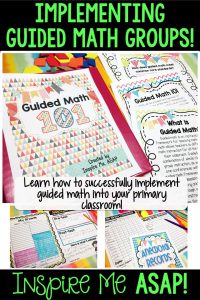
Does your district use MAP data? Well, my MAP scores have always been very strong with reading and my math scores overall have been slightly lower. I could blame the lower class average in math due to the fact that our school does not have any math interventions, I did not have any aides, there was handful of kiddos with ADD, anxiety, or other emotional issues….and the list goes on! But, doesn’t it seem that those students are now the majority of the classroom??? Why are we making excuses for these students? If they are showing growth (significant or not) in reading, shouldn’t they be showing the same growth in math? Why does it seem like there is this stigma with “math is harder?” I asked myself these tough questions and realized that I needed to overhaul my math instruction.
Whether I wanted to or not, was ready or not, something had to change. For my sake, for the sake of my current and future students. I then began to experiment with guided math. I searched high and low for resources to help guide me in this new direction. I mean how hard can this guided math be, right? I was having successful results with guided reading, why not try it with math?? Fast forward hours and hours of searching for those high quality and descriptive resources that I mentioned above….they were far and few between! However, the one treasure that I found is Beth Newingham’s guided math…that woman is unbelievable!!! I modeled my guided math groups with Beth’s schedule and her teaching tips in mind. And let me tell you….I struggled!!! That first year was tough! It was very challenging to find engaging and creative resources for each of the different groups!!! And the planning…..it takes a lot of organization and planning. You are, after all, teaching three different math groups.
This was my very first guided math bulletin board: 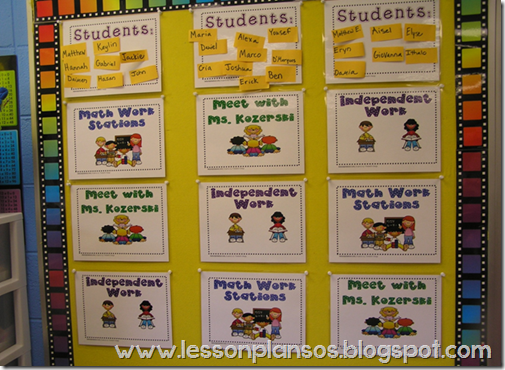 Using this bulletin board, I met all groups every day. I started my math instruction by meeting with my lowest group and then assigned them with their independent work for the next station. Using this model, my high group was the last group that I meet with and they started with independent work. The next year, I used a “Wild about Learning” design for my animal print themed classroom. The “wild things” were my students in each math group.
Using this bulletin board, I met all groups every day. I started my math instruction by meeting with my lowest group and then assigned them with their independent work for the next station. Using this model, my high group was the last group that I meet with and they started with independent work. The next year, I used a “Wild about Learning” design for my animal print themed classroom. The “wild things” were my students in each math group.
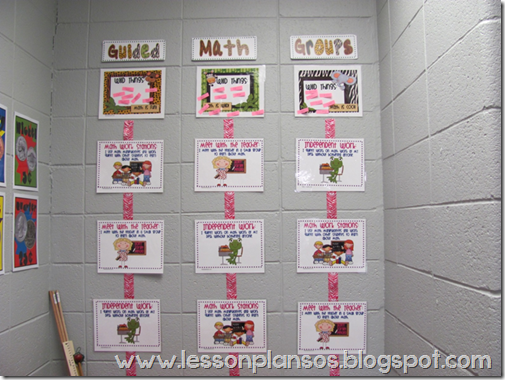 After getting two years of guided math under my belt, I was then ready to start a math workshop approach! I was still looking for a model that provided me with more flexibility to meet with one group a bit longer that the scheduled 20 minutes or meet with several students in a math conference. It was very difficult for me to plan three different math groups every day…again making sure that I was TRULY differentiating their instruction!!! (NOT giving them worksheets!!!!) This is the math workshop bulletin board that I am currently using:
After getting two years of guided math under my belt, I was then ready to start a math workshop approach! I was still looking for a model that provided me with more flexibility to meet with one group a bit longer that the scheduled 20 minutes or meet with several students in a math conference. It was very difficult for me to plan three different math groups every day…again making sure that I was TRULY differentiating their instruction!!! (NOT giving them worksheets!!!!) This is the math workshop bulletin board that I am currently using: 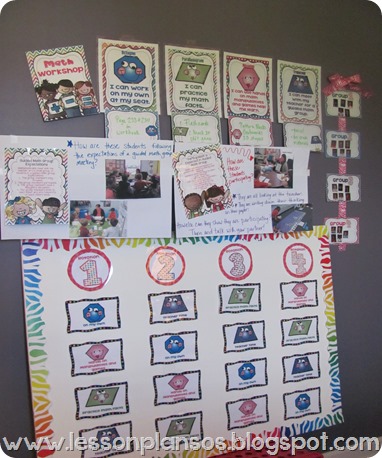 Whether you decide to use a guided math or a math workshop approach, there are a few “must haves!” Wherever you are at with your math instruction, I am hoping these tips will help you!! A special space for you to work with a small group of students:
Whether you decide to use a guided math or a math workshop approach, there are a few “must haves!” Wherever you are at with your math instruction, I am hoping these tips will help you!! A special space for you to work with a small group of students: 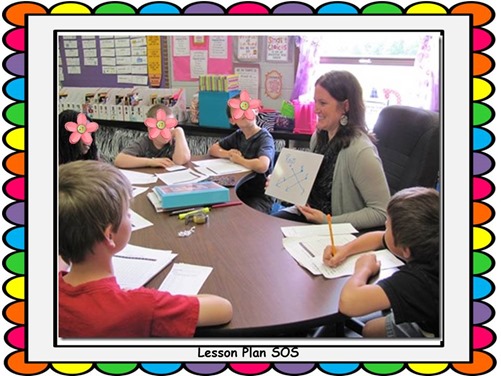 In the picture above, I am teaching my mathematicians a geometry lesson about different types of lines. I use the kidney bean table, which is what I also use for guided reading groups, when I want to use my dry erase materials to draw or illustrate concept. Although you can’t see in the picture, the students are sitting and facing ME!!! I, on the other hand, and facing the rest of the class so that I can monitor all of their whereabouts.
In the picture above, I am teaching my mathematicians a geometry lesson about different types of lines. I use the kidney bean table, which is what I also use for guided reading groups, when I want to use my dry erase materials to draw or illustrate concept. Although you can’t see in the picture, the students are sitting and facing ME!!! I, on the other hand, and facing the rest of the class so that I can monitor all of their whereabouts.
You KNOW what I mean! 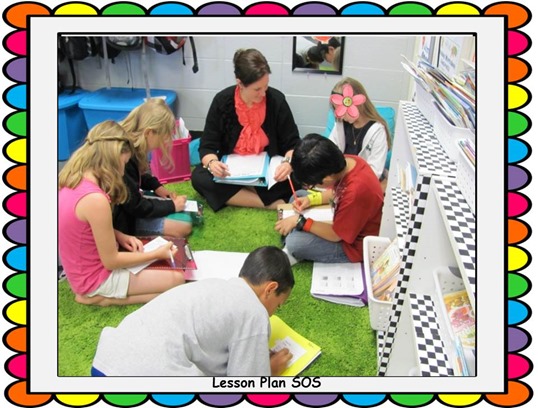 In this picture, I am working with a groups of students who are taking their “M and M’s” which is just a fancy way that I get the students excited about taking their daily “Math Minutes.” I don’t real believe in the whole “mad minute” philosophy, so I just call that time math minutes. Instead of doing math minutes as a whole class quick check, I like to use this small group format.
In this picture, I am working with a groups of students who are taking their “M and M’s” which is just a fancy way that I get the students excited about taking their daily “Math Minutes.” I don’t real believe in the whole “mad minute” philosophy, so I just call that time math minutes. Instead of doing math minutes as a whole class quick check, I like to use this small group format.
After the math minute, we move right onto the guided math lesson! 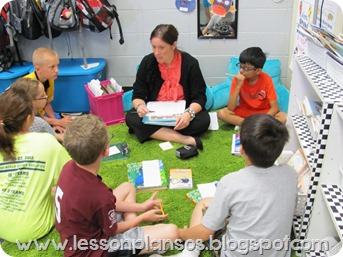 Again, in this picture, my back is against a wall so that I can see the rest of the class and monitor what they are doing. The students in the group have their backs to the rest of the class. That way, they will not get as easily distracted by what the other students are doing during their work time.
Again, in this picture, my back is against a wall so that I can see the rest of the class and monitor what they are doing. The students in the group have their backs to the rest of the class. That way, they will not get as easily distracted by what the other students are doing during their work time.
An organized space in your classroom where you can store all of your math manipulatives: 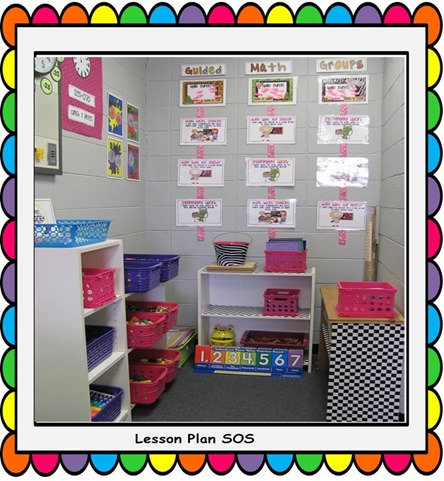
With lots of high quality math manipulatives!!! 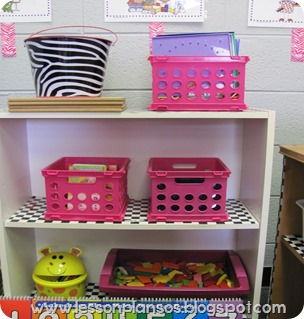 I have taught kindergarten, first grade, second grade, (now teaching) third grade and even gifted students at Northwestern University. EVERY grade level has benefited from these same manipulatives, just with different focuses for the content areas in math! I found so many of these manipulatives at garage sales, teachers who were retiring, or teachers who were just giving them away. Just like my classroom library, my little nook of math manipulatives has grown so much over the years.
I have taught kindergarten, first grade, second grade, (now teaching) third grade and even gifted students at Northwestern University. EVERY grade level has benefited from these same manipulatives, just with different focuses for the content areas in math! I found so many of these manipulatives at garage sales, teachers who were retiring, or teachers who were just giving them away. Just like my classroom library, my little nook of math manipulatives has grown so much over the years. 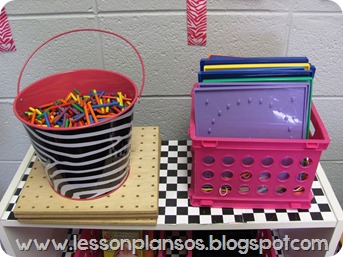 In the picture above, there are geo boards and peg boards. The students below are using peg boards during their work time for math workshop.
In the picture above, there are geo boards and peg boards. The students below are using peg boards during their work time for math workshop. 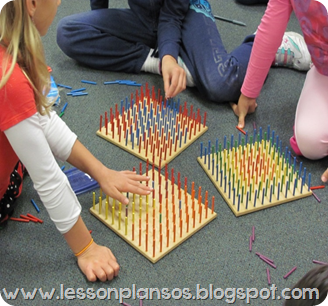 Pattern blocks, unifix cubes, fraction strips, oh my!!!
Pattern blocks, unifix cubes, fraction strips, oh my!!!
Again, I have used pattern blocks with kids in grades kindergarten through third grade! In Kindergarten, I used them to teach patterns, colors, and basic shapes. In third grade, I use them for tessalations, making arrays, and fractions. I just love how versatile manipulatives are….that could be a whole separate post! 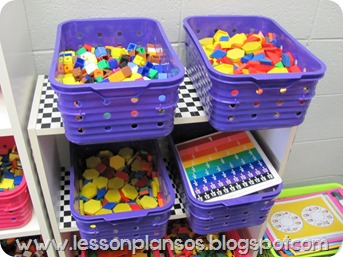
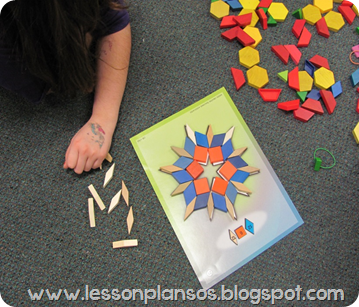 In the picture above, the student is learning about rotational symmetry using the pattern block cards (Learning Resources) At the beginning of the year, I spend at least a solid week of my math mini-lessons during my math workshop time to focus exclusively on how we use manipulatives as a TOOL to help us learn abstract math concepts. Below is one of our anchor charts from our mini-lessons about working with manipulatives at the beginning of the year:
In the picture above, the student is learning about rotational symmetry using the pattern block cards (Learning Resources) At the beginning of the year, I spend at least a solid week of my math mini-lessons during my math workshop time to focus exclusively on how we use manipulatives as a TOOL to help us learn abstract math concepts. Below is one of our anchor charts from our mini-lessons about working with manipulatives at the beginning of the year: 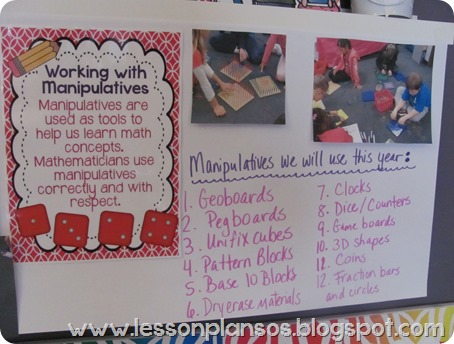
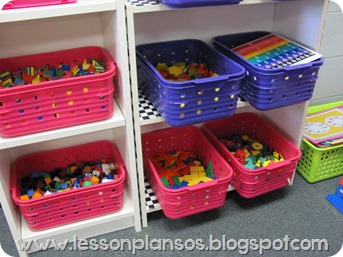 Teachers pay Teachers has been a lifesaver for printing out awesome math games to use during my math workshop work time!!!
Teachers pay Teachers has been a lifesaver for printing out awesome math games to use during my math workshop work time!!! 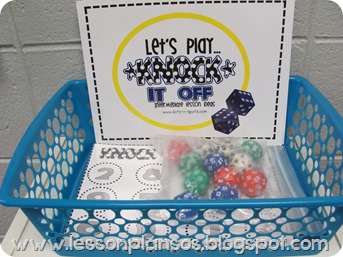 I adore Becky…and I adore her games even more!!! My students love her resources, which you can find on her Dots N Spots blog or TpT store: She has amazing FREEBIES!!!
I adore Becky…and I adore her games even more!!! My students love her resources, which you can find on her Dots N Spots blog or TpT store: She has amazing FREEBIES!!! ![]()
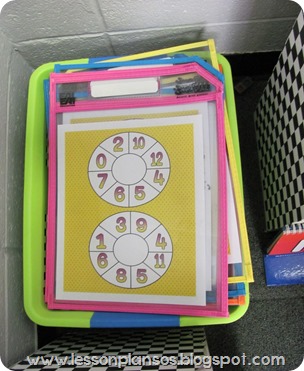 Ginger has some AWESOME math fact wheels that my students use to practice their math facts in a fun way. Another AMAZING freebie!!! Check out Ginger’s math fact wheels by clicking on the image above!
Ginger has some AWESOME math fact wheels that my students use to practice their math facts in a fun way. Another AMAZING freebie!!! Check out Ginger’s math fact wheels by clicking on the image above!  MOOOORE manipulatives!!! I love these Georeflector mirrors to find the line of symmetry with pattern blocks. I found these mirrors a few years ago from Learning Resources.
MOOOORE manipulatives!!! I love these Georeflector mirrors to find the line of symmetry with pattern blocks. I found these mirrors a few years ago from Learning Resources. 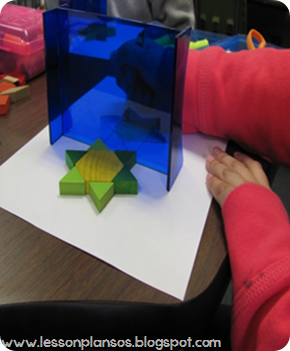
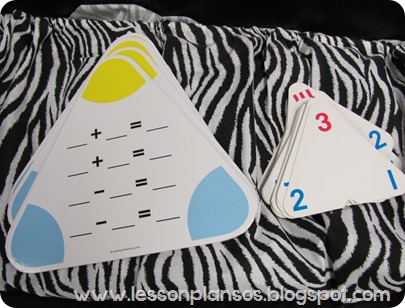
 Once you have the must haves for your little mathematicians, you are then ready to group your students!!
Once you have the must haves for your little mathematicians, you are then ready to group your students!! 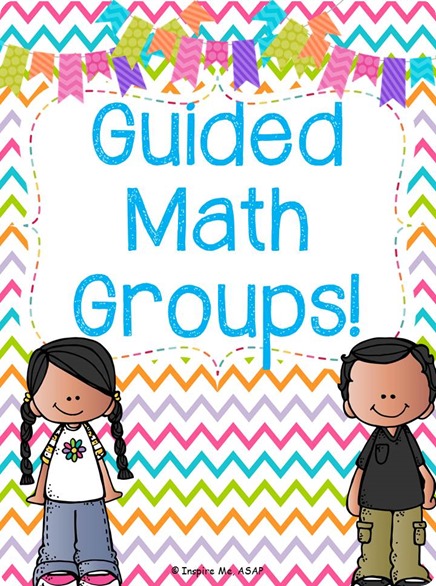 I previously thought that it was much easier to group my students by their reading level, because my district mandates that we use the Fountas and Pinnell leveling system.
I previously thought that it was much easier to group my students by their reading level, because my district mandates that we use the Fountas and Pinnell leveling system.
At the beginning, middle, and end of every school year, we “simply” test our students for their instructional reading level and then form groups based on that data (along with MAP data). However, I found that grouping students for math is similar to reading- groups are formed based on data, change frequently, and have different learning targets based on their level of understanding.
The key is to take advantage of using… 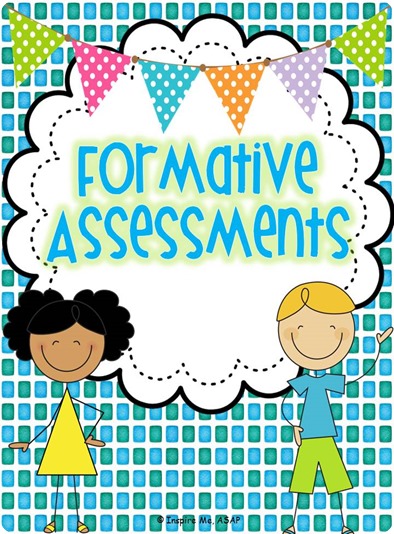 I give formative assessments throughout a unit to determine a student’s progress and if they need additional support or enrichment. Formative assessments are on-going and used to improve and direct instructional methods. Student feedback is a KEY component to authentic and valuable formative assessments!
I give formative assessments throughout a unit to determine a student’s progress and if they need additional support or enrichment. Formative assessments are on-going and used to improve and direct instructional methods. Student feedback is a KEY component to authentic and valuable formative assessments!
My students monitor their progress with performance tasks, exit slips, and graphing their results of chapter tests. These results guide my instruction by allowing me to provide a different instructional strategy to help a student further grasp a solid understanding and mastery of the topic. Here is an example of how I use assessments during guided math.
My students’ compare their pretest with their post test, and determine the growth they made. After each module, the students graph the results of their pretest and then their post test. They identify how many correct they had on each and fill in the bar graph. Students then identify the difference, and determine their growth.
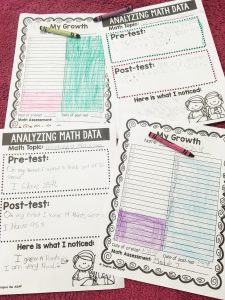
A very important component to using a working approach for math is allowing the STUDENTS holding themselves accountable for their learning. My students actually share this data with their parents during their student led conferences. It is amazing to hear these kiddos explain how they grew for each math module!
Can you imagine the sense of pride and accomplishment that these students feel when they discover the strong growth they made? That is a powerful motivator! One point I am sure to stress is that we need to focus on GROWTH. Based on the results of the pretest, I place my students into guided math groups. I then gather all my materials to differentiate instruction based on the results of the students in each group.
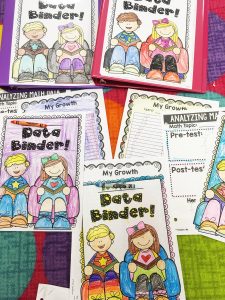
The hardest part of guided math (in my opinion!) is making:  is making lesson plans for each group of students!!! I know that many teachers simply teach the same lesson to all the different guided math groups. But…that is not truly differentiating instruction! In a whole separate post, I with go into depth on differentiating math instruction for guided math groups.
is making lesson plans for each group of students!!! I know that many teachers simply teach the same lesson to all the different guided math groups. But…that is not truly differentiating instruction! In a whole separate post, I with go into depth on differentiating math instruction for guided math groups.
I also hope to write another post about having… 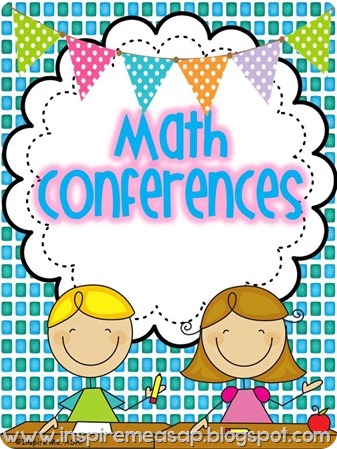 with my students.
with my students.
WHEW!!!!! I am realizing that this is a really ***LONG*** post and appreciate if you are still reading it at this point!!!
If you are looking for some inspiration to jazz up your own math instruction, you will find the materials listed in the post are included in my new math files!
Guided Math 101:
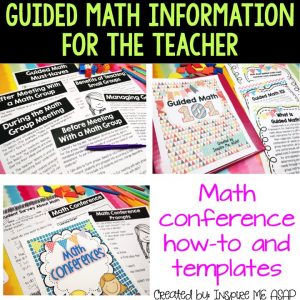
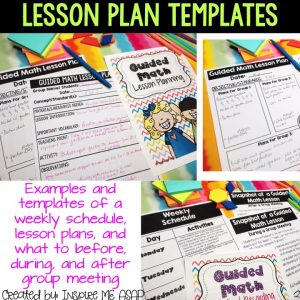
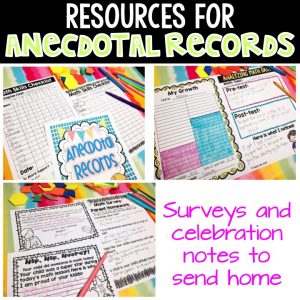
Guided Math Resource Description:
1. Introduction to Guided Math- Definition and breakdown of guided math, addressing CCSS with a guided math approach, and poster with a list of mathematical practices.
2. Managing Guided Math Groups- Information to guide the teacher in creating and managing groups, list of benefits to use small groups, breakdown of what to do before/during/after group meetings.
3. Math Survey for Parents and Students- Determine how your students feel about math at the beginning of a new school year.
4. Math Manipulatives Resources- Math manipulatives contract and think about it sheet, as well as 26 labels (in color) for you to label your math manipulatives.
5. Pirate Glyph- How “arrr” your students feeling about math? This is a great activity to do with your kiddos as you embark on your guided math journey! Students complete the guided math survey, use the legend to color their pirate template according to how they answered the questions on the survey. Pirate craft also includes a “math toolkit” for students to write about important math tools they use in their every day life. Color bulletin board posters, directions, and student reproducibles included.
6. Formative Assessment- One page summary of formative assessment, color poster to write down the learning target, notes to send home to parents to celebrate student achievement and notification of concerns.
7. Anecdotal Records- Templates to keep, organize, and write anecdotal records for your students. Resources include 4 different forms for you to choose from.
8. Math Conferences- Two math conference templates for you to choose from, conference prompts, and compliments to give to students.
9. Organizing Groups for Guided Math- Daily and weekly schedule, templates, and examples.
10. Guided Math Bulletin Board Display- Posters to print and display for your guided math bulletin board! Title of posters include: Mathematicians, Meet with the Teacher, Math Facts, Math Work Stations, Independent Work. Students will use the bulletin board display to identify the rotation schedule and where they need to be for each rotation.
11. Guided Math Lesson Planning- Five different lesson plan templates for you to choose from. Write your lessons for each group on the template you choose. Also includes information about what the teacher does before, during, and after a guided math group.
12. Student Data Collection- Students take ownership over the assessment process by analyzing their growth from pre to post- test. There are three different templates to choose from.
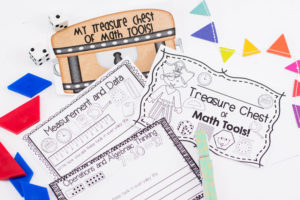
Purchase Guided math on Teachers Pay Teachers by click HERE.
Save 10% by purchasing Guided math directly from my website.
Math Workshop 101:
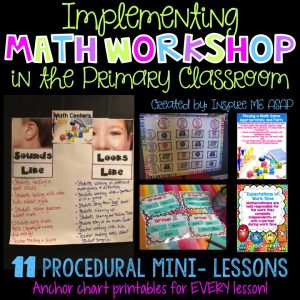
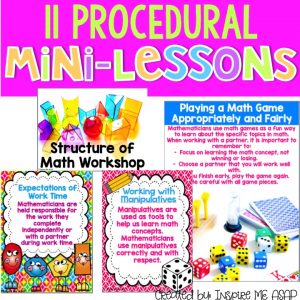
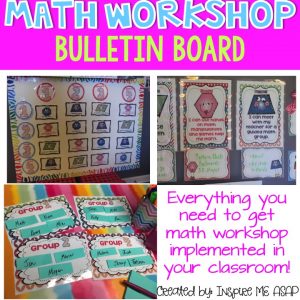
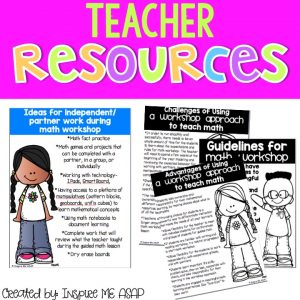
File Description of Math Workshop:
1. Introduction to Math Workshop- Definition and breakdown of math workshop, list of advantages and challenges of using a workshop approach to teach math, and a list of guidelines to keep in mind when starting math workshop.
2. Color Posters Explaining Math Workshop Structure- Five posters that break down each part of math workshop, including: the overall structure of math workshop, the mini-lesson, work time, closing/sharing. These pages can be displayed in your classroom or kept as a reference in your math/lesson planning binder. Also included is a list of ideas for activities to use during independent work time.
3. Creating Anchor Charts– Tips and examples of how to create effective anchor charts as part of your math workshop mini-lessons.
4. List of Procedural Mini-Lessons- List of 11 procedural mini-lessons that are suggested to teach as you implement a workshop approach to teaching math.
5. Anchor Charts- For every procedural mini-lesson, there is at least one color poster that you can use to display with your anchor chart. Some mini-lessons have multiple color pages for you to print and display.
6. Accountability with Math Workshop- Ideas for how to keep your kiddos accountable during math workshop! Included are four different recording sheets that students can fill out to track their work for the day/week. You could also use these recording sheets as exit tickets to informally assess the students’ understanding of the lesson.
7. Math Workshop Bulletin Board Display- I explain how to display the posters to create a math workshop rotation bulletin board. Color posters for the following rotations are included: teacher time, manipulatives and games, on my own, and practice math facts.
8. List of Activities for Each Rotation- There is a color poster with a shape to print and display for your students. On these posters, you can write the list of activities/options for the students to complete at each rotation. The shapes on the posters are as follows: parallelogram, octagon, trapezoid, hexagon.
9. Math Groups Display- Print these color posters to help the students identify the group they are in. Directions and a picture are included to explain the math group display.
10. Organizing Math Materials- Print the color shape posters (four ½ sheet posters) and post it next to the bin of materials that are available for each rotation.
Purchase Math Workshop on Teachers Pay Teachers by click HERE.
Save 10% by purchasing Math Workshop directly from my website.
Both Math Workshop AND Guided Math AND some extra goodies….are included in the
Crash Course in Guided Math and Math Workshop: The Ultimate Math Resource for any Teacher Bundle!
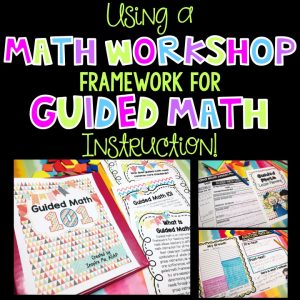



The following files are included: Guided Math, Math Workshop, Math Workshop Venn Diagram, and Guided Math Binder Cover Pages.
Guided math 101 (118 pages)
1. Introduction to Guided Math- Definition and breakdown of guided math, addressing CCSS with a guided math approach, and poster with a list of mathematical practices.
2. Managing Guided Math Groups- Information to guide the teacher in creating and managing groups, list of benefits to use small groups, breakdown of what to do before/during/after group meetings.
3. Math Survey for Parents and Students- Determine how your students feel about math at the beginning of a new school year.
4. Math Manipulatives Resources- Math manipulatives contract and think about it sheet, as well as 26 labels (in color) for you to label your math manipulatives.
5. Pirate Glyph- How “arrr” your students feeling about math? This is a great activity to do with your kiddos as you embark on your guided math journey! Students complete the guided math survey, use the legend to color their pirate template according to how they answered the questions on the survey. Pirate craft also includes a “math toolkit” for students to write about important math tools they use in their every day life. Color bulletin board posters, directions, and student reproducibles included.
6. Formative Assessment- One page summary of formative assessment, color poster to write down the learning target, notes to send home to parents to celebrate student achievement and notification of concerns.
7. Anecdotal Records- Templates to keep, organize, and write anecdotal records for your students. Resources include 4 different forms for you to choose from.
8. Math Conferences- Two math conference templates for you to choose from, conference prompts, and compliments to give to students.
9. Organizing Groups for Guided Math- Daily and weekly schedule, templates, and examples.
10. Guided Math Bulletin Board Display- Posters to print and display for your guided math bulletin board! Title of posters include: Mathematicians, Meet with the Teacher, Math Facts, Math Work Stations, Independent Work. Students will use the bulletin board display to identify the rotation schedule and where they need to be for each rotation.
11. Guided Math Lesson Planning- Five different lesson plan templates for you to choose from. Write your lessons for each group on the template you choose. Also includes information about what the teacher does before, during, and after a guided math group.
12. Student Data Collection- Students take ownership over the assessment process by analyzing their growth from pre to post- test. There are three different templates to choose from.
Math Workshop (96 pages)
1. Introduction to Math Workshop- Definition and breakdown of math workshop, list of advantages and challenges of using a workshop approach to teach math, and a list of guidelines to keep in mind when starting math workshop.
2. Color Posters Explaining Math Workshop Structure- Five posters that break down each part of math workshop, including: the overall structure of math workshop, the mini-lesson, work time, closing/sharing. These pages can be displayed in your classroom or kept as a reference in your math/lesson planning binder. Also included is a list of ideas for activities to use during independent work time.
3. Creating Anchor Charts- Tips and examples of how to create effective anchor charts as part of your math workshop mini-lessons.
4. List of Procedural Mini-Lessons- List of 11 procedural mini-lessons that are suggested to teach as you implement a workshop approach to teaching math.
5. Anchor Charts- For every procedural mini-lesson, there is at least one color poster that you can use to display with your anchor chart. Some mini-lessons have multiple color pages for you to print and display.
6. Accountability with Math Workshop- Ideas for how to keep your kiddos accountable during math workshop! Included are four different recording sheets that students can fill out to track their work for the day/week. You could also use these recording sheets as exit tickets to informally assess the students’ understanding of the lesson.
7. Math Workshop Bulletin Board Display- I explain how to display the posters to create a math workshop rotation bulletin board. Color posters for the following rotations are included: teacher time, manipulatives and games, on my own, and practice math facts.
8. List of Activities for Each Rotation- There is a color poster with a shape to print and display for your students. On these posters, you can write the list of activities/options for the students to complete at each rotation. The shapes on the posters are as follows: parallelogram, octagon, trapezoid, hexagon.
9. Math Groups Display- Print these color posters to help the students identify the group they are in. Directions and a picture are included to explain the math group display.
10. Organizing Math Materials- Print the color shape posters (four ½ sheet posters) and post it next to the bin of materials that are available for each rotation.
Also included…
Cover pages for guided math binder (3 different designs, 30 pages) A creative and colorful way to get your math resources organized! Knock the socks off your administration with your organizational skills!
Math workshop Venn Diagram (15 pages) An effective, creative, and interactive lesson to teach your students about the expectations about math workshop/guided math. This makes a great reference to refer to throughout the school year!
Purchase the Guided Math and Math Workshop bundle on Teachers Pay Teachers by click HERE.
Save 10% by purchasing the Guided Math and Math Workshop bundle directly from my website.
Do you use a guided math approach for math? How is it working for you? Any questions you have or tips to share? I sure hope you are enjoying your summer!!!

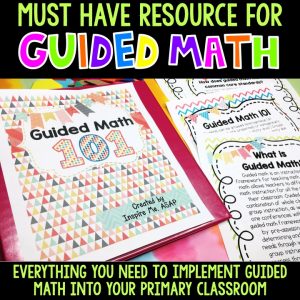




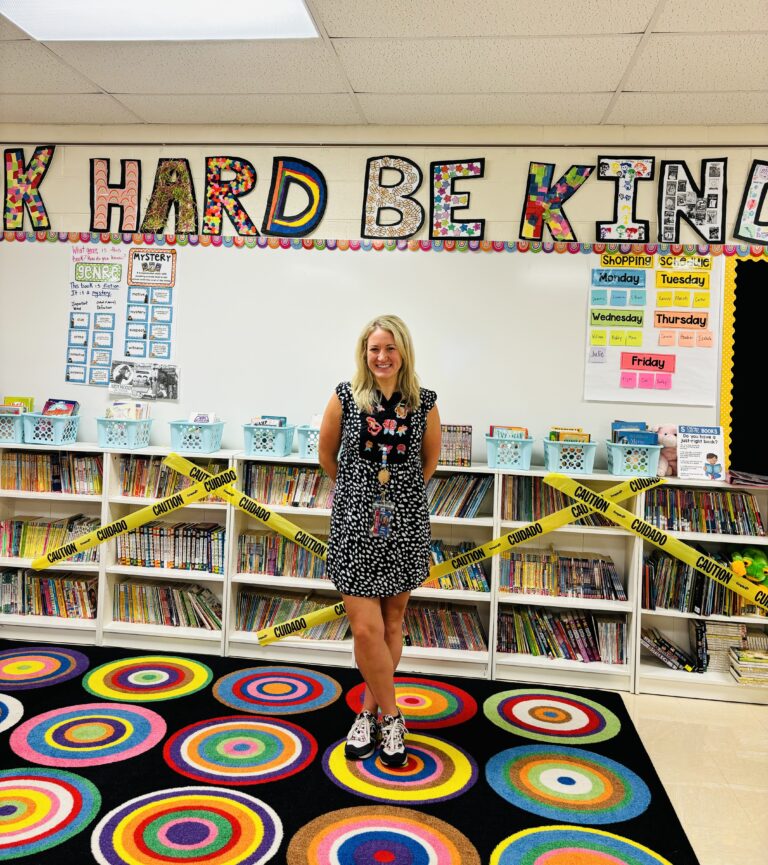



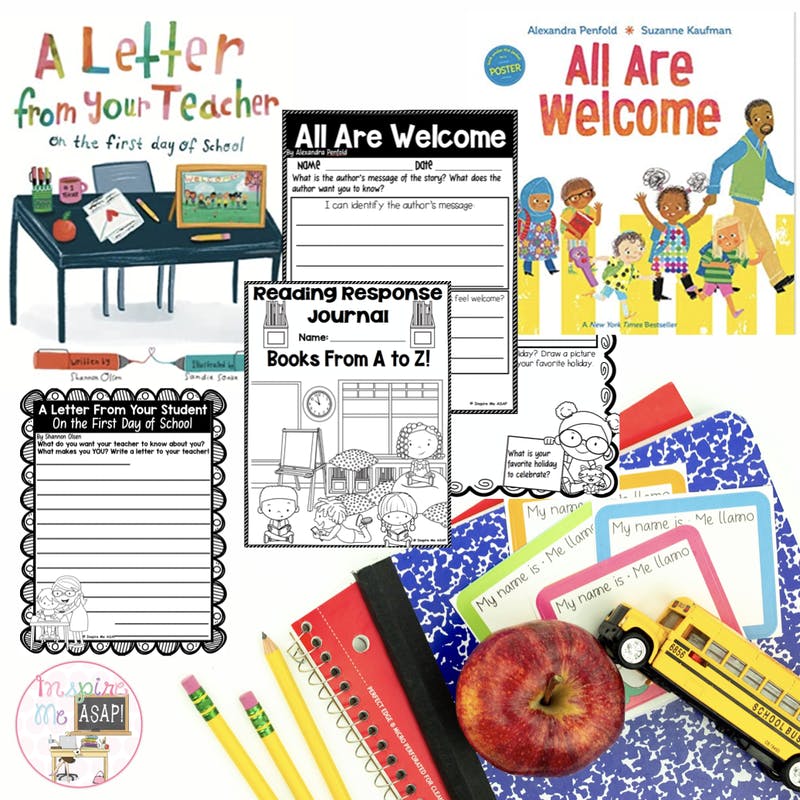
28 Responses
This looks wonderful! I tried doing guided math last year and I just couldn't get into a rhythm. This is on my wishlist. Thanks so much for sharing your ideas!
Swimming into Second
I am so glad you posted this blog. I have your bundle sitting in my wishlist. However, I am unsure if this would be fourth grade appropriate. Although, I do not have my class list I usually get the the lower groups according to state standardized test scores. Our focus is mainly on multiplication, division, and fractions. Are there portions of this bundle that address these particular concepts?
Ivett
I decided that this upcoming school year I would revamp my math instruction and this is how I decided to do this. I'm a fourth grade teacher and really want to try something new with my kiddos. We don't do our MAP testing until after all the primary grades have done theirs. Do you start the workshop and guided math prior to your MAP testing based on assessments you have given?
Have you read Comprehending Mathematics by Arthur Hyde? He bridges mathematical teaching with reading strategies and it's an eye opening read! I suggest reading it to anyone interested in improving their mathematics instruction! Catherine Twomey Fosnot's books about Young Mathematicians at Work is fantastic too. All of Bob Wright's resources for Teaching Number will blow your mind too!
Can't wait to take a look at your new resources!
Lauren
Go Fourth and Inspire
Great post about the basics of guided math. I have used it for the past two years. The best part is that the kids LOVE it.
EmilyK
my big focus this year is going to be on guided math and individual math conferences. Thank you for doing such an amazing job explaining what you do!
Kimberley
First in Maine
I bought this and already set up my board in the classroom. I am now researching and creative tons of engaging math workshop activities. I am doing some pre-tests and everything! You're making me go all out for this! THanks so much! My kids are going to benefit greatly from this!
Jessica*
The Teacher Talk
I'm teaching 2nd grade Math for the first time. I've taught 4th grade Math, but it has been over 7 years. This was a really good refresher. Thank you!
Kristin
Teachntex
Thank you for sharing! Do you change what the independent groups do weekly based on skill being taught? What are the other students doing while you work with small group?
Patti
This post was great! Revamping my math instruction is my goal for the new school year. Your ideas are wonderful. I am going to go check out all your goodies on TPT. I am about the read Math Work Station by Debbie Diller. Thanks so much for sharing!
I love, love this post!! I have been doing guided math for three years now and I feel that I get better each year, but I like the idea of a math workshop (I am huge into the benefits of reading workshop). I have to admit, my low and middle groups get the same lesson with different levels of support, but my higher kids do get a challenge when they are with me. I love the idea of the kids keeping track of their progress – usually I am just the one who knows their pre-test and post-test. I think it would be great to staple their recording sheet with their pre-tests and post-tests and send it home for parents to see!
Thank you so much for this post!
Bobbi
Bitty Bilinguals
Oh man, this would be a lifesaver! Our district threw out both the math and reading curriculum and I don't even know where to start. My wish list is getting out of control ;)
Thank-you so much for this informational post. Yesterday I bought your Crash Course and was totally amazed with that so this was the perfect way to start my day!
Thank you for posting this. I teach first grade and we are departmentalizing next year. I'll be teaching math/science. Are these packs something I would be able to use in first grade or are they for older grades?
Teachin' First
krisspradlin4@yahoo.com
looks fabulous!
I'll repeat Kristy ^ question above – I teach K-1, is the pack suitable?
What wonderful information! This post will be a resource I come back to several times to read and apply to my instruction. I'm beginning Guided Math with my 4th graders and this is just the support I needed. Thank you so much for sharing and I can't wait to read more!
Hi Kristy and Liz!!! Thanks for the question! Yes, I do believe is suitable for you kiddos! Guided math/math workshop is more of a philosophy and a way to teach, which is what all the files focus on. Rather than including grade level specific math content (place value, geometry, etc.), this file is more for the teacher and provides the teacher with information and resources to effectively use small group math instruction. It provides templates for lesson plans, conferences, scheduling, feedback forms, learning targets, etc. The combined file has both guided math and math workshop, plus the math binder cover pages and Venn diagram. Long story short, yes, I believe it is adaptable for teachers of grades K-5!!! THANKS for visiting our blog!!! :)
Hi Jessica (Teacher Talk!)- I would love if you were to send me some pictures of your bulletin board that you set up already in your classroom!!!! :) melissa
Our school just adopted a new math program which pretty much dictates whole group instruction and small group instruction for RTI only. I am not sure if math workshop will be doable with our new math program. Any thoughts?
As usual, you ladies have out done yourselves! I can say that after a rough year last year, that your products helped to make the year run smoother! Your Guided Math 101 is JUST what I needed for the upcoming year! I have purchased it, and I cannot wait to use what I am learning from you! Thank you again!
Wow! This post looks like it too you a while and it's so full of great info. Thank you for sharing your wealth of knowledge!
Kids Math Teacher
WOW! I just found this as a link from Pinterest and I am SO impressed! Thank you so much for this wealth of information. I can't wait to take a look at some of your links! I have always done some sort of "guided math groupings" at least 3 days a week for the past few years but without as much accountability for the students. It's really just been my way to manage their learning as our class sizes kept increasing. I LOVE the idea of them graphing their pre and post assessments and providing the formative assessments along the way. This post inspired me so much! Thank you!!!!!
I just got back from a guided math trainer conference in Chicago so I'm hoping to get some blog posts up in the next week or so. Love to see how you structure your math instruction in your classroom- fun to read and lots of helpful tips! :-) I agree there aren't many resources out there.
Real Teachers Learnw
This is an amazing post! I am teaching math again this coming year after just doing language arts for three and this is exactly what I needed to read to pep me up!
I realize this post took you a TON of time to write, but I am so thankful that you did!!!!!
Kelly
Koonce’s Korner
Thank you for sharing!
I think you would love the book, Math Exchanges: Guiding Young Mathematicians in Small-Group Meetings by Kassia Omohundro Wedekind …It is excellent!
Love this information!! Thank you for taking the time to write it. It is exactly what I have been looking for to start guided math. Do you teach a whole group lesson first of teach all your lesson in guidec math lessons? Thanks again!!
This is great information! Currently I am teaching 6th grade math I'm hoping to start guided math or math workshop this year. Which do u think would work better?
FINALLY! You are truly answered prayer. I totally agree with you that there are very few math resources out there that help to get our math programs up to speed. My students overall are very weak in their understanding of numbers and number sense and I spend countless hours trying to find resources to strengthen those areas and am so stressed at the same time to teach he concepts that are my grade level TEKS. I teach in Texas so we use the TEKS, not common core. Just looking at the new TEKS and the level at which my third graders who were my second graders last year scares me to death! The lessons presented in the text book are in depth and don't allow a lot of time on concepts that I know were hard for the kids last year. With so much pressure on me to get the test scores up and the rigorous math TEKS how do you get it all taught when using guided math? I have been wanting to do guided math but up until today when I found your Guided Math 101 I did not feel comfortable to take it on fully. In second grade I had a rotation board and the students had buckets in which I placed a variety of math games, task cards, etc. for them to work on concepts that have been taught and mainly used these as my spiral review. When children finished their morning warm up they could go to the buckets for extended learning. I would then go desk to desk or pull a small group depending on the need to work with my struggling students. Then we would jump into the math lesson for the day which as presented whole group. I use group learning and totally hands-on learning but it takes me the rest of the math time to get through all the stages of the lesson with no break out time. It seems guided math/math workshop have you do a short mini-lesson before you break out in groups. I still cannot understand how you get through all the lesson for the day as allotted by the scope and sequence and stay on track with pacing when you do short mini-lessons and groups each day. I know the lesson carries over to the small groups but I can't seem to get all the information delivered that way. I also am in charge of the science so if I run over trying to do my groups I then cut into the science program and get behind there. I know working in groups help to better target my instruction and differentiate I am at a lost how to get it all done and not feel I am getting behind. We take our big state test, STAAR, in April so I have to have all the TEKS covered by that time or the students will not be prepared.
The other question I, do you have for sale or would you be willing to sell your third grade lesson plans that you use in your guided math groups. I need something to follow to help me begin this journey. I know the lessons have to be changed based on my learners and my TEKS but I need a map to help me see the flow of this and how you accomplish it all. I would be willing o pay what you think it is worth for the time you have put into them. I am desperate to get our ids math instruction at the level it should be and I believe guided math is the way. Our district does not have a lot of money and is on a tight budget so it is up to me to find and purchase the resources to make this happen at least starting with my classroom and then hopefully I can share with others once I get some experience.
Last question, could you tell me what the difference is between guided math and math workshop? It sounds like guided math is the direction I need to go but I am curious what the difference is. I am so sorry for the length of this email but I am discouraged right now since I had to move grade levels and I only have the summer to really study this out and get my plan together for next year.
My email is: ty95@hctc.net Could you please respond to this email address.
Thank you for any help you can offer. I will be buying your products from here on out but am so interested in the group lesson plans and how you tackle this day to day.
Thank you for writing this post. It really was a God send for me.
Jan Salzman